More Odell History
Back to the Odell Home Page
Odell, the Hill of Woad
by Eric Rayner (exerpts from the 'Bedfordshire Magazine', circa 1970)
The King’s Thanes of Saxon days were landed gentry, some with large estates in several countries. The lands of Levenot, a wealthy thane of King Edward the Confessor, included Wahull, the modern Odell. Odell was originally called Woad-hill from the plant woad once used as a dye and apparently cultivated in Saxon days and later. The modern spelling is a corruption; loss of the initial letter did not occur until about 1500 and Wodell continued to alternate with Odell during the sixteenth century, and even became Woodhill later, until Odell established itself. Within memory some of the older inhabitants still called it Woadle.
When it came to sharing out the spoils after the battle of Hastings, Levenot’s lands fell, with the title of baron of Odell, to Walter the Fleming. We hear of Walter as early as 1068, so it is probable that he came over with the Conqueror and fought at Hastings (see Beds Mag., i, 269-71).
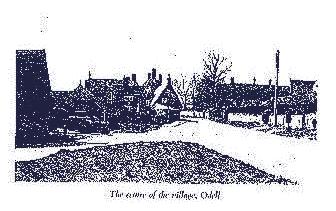 Of his successors, the lords of Odell Castle, his great-great-grandson, Simon, was a wild fellow who was involved in a raid on the abbey of Ramsey and who sided with the young Prince Henry when he was revolting against his father. His son, another Simon, was as devout as his father was roisterous, and met his death by falling overboard in Acre harbour whilst on a crusade in 1191.
Of his successors, the lords of Odell Castle, his great-great-grandson, Simon, was a wild fellow who was involved in a raid on the abbey of Ramsey and who sided with the young Prince Henry when he was revolting against his father. His son, another Simon, was as devout as his father was roisterous, and met his death by falling overboard in Acre harbour whilst on a crusade in 1191.
A later Walter made the arduous pilgrimage to the shrine of St. James of compostella at Santiago, and John, his son, was summoned by Edward I to help him cope with the rebellious Welsh princes, and also to Shrewsbury "to ordain what should be done with David", Prince Llewellyn’s brother, who was condemned to be hanged, drawn and quartered.
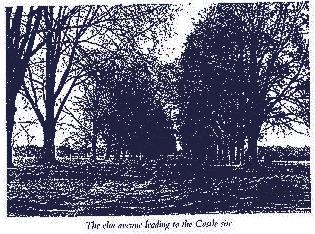 By the sixteenth century, the Odell estate had come to Agnes Woodhall (the surname had taken this form in the 1300s). She married a Hockliffe man, Richard Chetwood, and their son Richard sought vainly to have his claim as baron of Odell recognised, a claim his eighteenth and nineteenth-century descendants revived without success. In 1633, Richard sold the estate to William Alston and, after five hundred years, the Wahulls or Woodhalls disappeared from Bedfordshire history.
By the sixteenth century, the Odell estate had come to Agnes Woodhall (the surname had taken this form in the 1300s). She married a Hockliffe man, Richard Chetwood, and their son Richard sought vainly to have his claim as baron of Odell recognised, a claim his eighteenth and nineteenth-century descendants revived without success. In 1633, Richard sold the estate to William Alston and, after five hundred years, the Wahulls or Woodhalls disappeared from Bedfordshire history.
Except for its earthworks, rising above the north bank of the Ouse, their once impregnable castle had lapsed into ‘strange Ruins’ by the time William Alston took over. He built himself a new residence on the site, incorporating the remains of the keep, the oval motte of the old castle still held up by a retaining wall. An eighteenth-century tenant, Lady Wolstenholme, mother of thirteen children, married an Alston, father of thirteen children and, perhaps to accommodate their tremendous brood, made considerable alterations and enlargements.
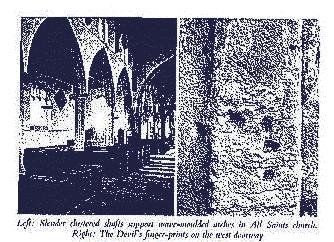 And so it stood, a stone-build mansion of some magnificence, with its stable yard and broad terraced lawns which were once the outer bailey, the great well called King John’s Well, its "Monk’s hall", panelled in dark oak, its Renaissance south-facing façade, with finely moulded window frames and chimney-caps, and its rooms hung with old oil paintings. Until February 24th, 1931.
And so it stood, a stone-build mansion of some magnificence, with its stable yard and broad terraced lawns which were once the outer bailey, the great well called King John’s Well, its "Monk’s hall", panelled in dark oak, its Renaissance south-facing façade, with finely moulded window frames and chimney-caps, and its rooms hung with old oil paintings. Until February 24th, 1931.
At that time, the occupant was Rowland Crewe Alston, who had succeeded to the depleted estate in 1901 (see ‘The Old Squire of Odell’, Beds Mag., iv, 223-7). On that sharp, cold February morning, at nine o’clock, smoke was seen billowing from the furnace-room and, shortly afterwards, the house was burning like a beacon. Bedford’s fire brigade did what it could, rescuing some of the furniture and pictures, but the building was gutted.
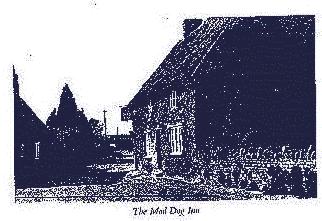 Old Mrs. Ashton, who lives in a little low-ceilinged cottage in the High Street, was a servant for many years in the big house and remembers it well: a whole sheep hanging in the cellar, the oil-lamps and candles, the dark panelling, the eighty-foot deep King John’s Well where the butler used to hang the champagne; and the ghost - a smoky black insubstantial apparition that frightened the life out of her. Others, too, claimed to have seen the spectre, but none knew to whom the unquiet spirit had belonged.
Old Mrs. Ashton, who lives in a little low-ceilinged cottage in the High Street, was a servant for many years in the big house and remembers it well: a whole sheep hanging in the cellar, the oil-lamps and candles, the dark panelling, the eighty-foot deep King John’s Well where the butler used to hang the champagne; and the ghost - a smoky black insubstantial apparition that frightened the life out of her. Others, too, claimed to have seen the spectre, but none knew to whom the unquiet spirit had belonged.
Now a new house, in the classical style, has arisen on the ancient site, the home of Lord Luke of Pavenham. For it, much of the old stone was re-used. The stables have been replaced by dwellings, King John’s Well has been filled in and only the piers of the seventeenth-century gates and the broad avenue of elms, with its regiment of rooks, still remain.
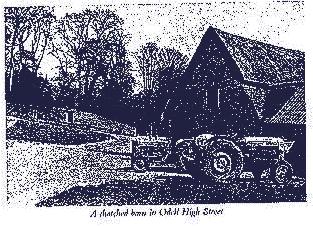 A stone’s throw away is All Saints Church, a noble fifteenth-century building with a tall and massive tower, made the more commanding by its high situation. Even the churchyard, with its chestnut trees, stands well above the level of the road. To the fact that it was built all at one time, the church owes its harmony of style and proportion. Brown ironstone was used for the ornament around the corona of the tower and at each angle are large crocketed pinnacles.
A stone’s throw away is All Saints Church, a noble fifteenth-century building with a tall and massive tower, made the more commanding by its high situation. Even the churchyard, with its chestnut trees, stands well above the level of the road. To the fact that it was built all at one time, the church owes its harmony of style and proportion. Brown ironstone was used for the ornament around the corona of the tower and at each angle are large crocketed pinnacles.
Inside, slender clustered shafts with lofty wave-moulded arches form four bays and stone heads hold up the timbered roof. The rood-screen is a tall, handsome structure and at the west end is another screen below a gallery, given by the Sir William Alston who died in 1637. Some of the seventeenth-century pews enclose the backs of mediaeval seats and the dozen or so crabbed old benches at the west end remain almost unaltered.
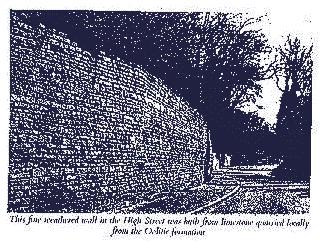 The priests’ seats are stepped in three levels under a traceried window. There is a Jacobean altar table and a pulpit of the same date with an iron frame close by which held the hour-glass by which former rectors timed their sermons. Lady Wolstenholme contributed a pulpit cloth and a velvet cushion on which she had embroidered her own cypher.
The priests’ seats are stepped in three levels under a traceried window. There is a Jacobean altar table and a pulpit of the same date with an iron frame close by which held the hour-glass by which former rectors timed their sermons. Lady Wolstenholme contributed a pulpit cloth and a velvet cushion on which she had embroidered her own cypher.
Now cracked and chipped, the old font dates back to the time of the building. From the north aisle, a circular staircase leads to the narrow rood-loft doorway.
Interesting survivals are the thirteenth-century coffin lid with a foliate cross carved in relief and some pretty white and gold glass roundels, which once showed the Evangelists’ symbols, as well as five seraphs in the east window.
Five bells of the peal of six are old. Three were made by James Keene of Woodstock in 1638, the fourth is twenty years older and the fifth was made by Hugh Watts. The modern bell was added in 1958.
A few years after he had arrived in the village, William Alston gave the church a large silver-gilt communion cup, which bears his arms, and a pattern in the same metal. His family, too, provided two of the rectors, both named Vere John. One served for forty-eight years, from 1714 to 1762, the other from 1829 to 1863. An impressive marble monument commemorates several of the family.
Indented in the western doorway, the visitor can still find the fingerprints on the Devil himself, made when he shook the tower in a paroxysm of rage because a lost soul, popularly supposed to be a wicked Sir Rowland Alston, had escaped his clutches and found sanctuary in the church.
Odell’s list of incumbents stretches back through the centuries to Robert of Dunton, who was installed in 1220. At Cardinal Pole’s visitation in 1556, the rector, Sir Oswald Butler, was severely reprimanded for marrying and was ordered to do public penance in All Saints and in St. Mary’s Church at Bedford. Another Visitation, in 1634, resulted in the suspension of Odell’s most famous rector, Peter Bulkeley (see Beds Mag., ii, 30-2). He was born in the village and succeeded his father as rector in 1624. Although a faithful member of the Church of England, he could not accept the Laudian discipline and used neither a surplice nor the sign of the cross in baptism, ‘accounting them ceremonies superstitious’. He emigrated to New England and helped to found the city of Concord, Massachusetts, where be became its first minister.
Another controversialist found the rectory of Odell a refuge. William Dillingham (1617?-1689), Latin poet, Doctor of Divinity and Master of Emmanuel College, became vice-chancellor of Cambridge University in 1659 but when opposition against him grew too strong, he retired to become rector of Odell from 1672 until his death.
Among the Alstons, Harrisons and Hartwells, the Ridges, Riseleys and Coopers that punctuate the parish registers throughout the seventeenth and eighteenth centuries, we find a William Misledine, who was struck by lightning while working in the fields. In 1760 was born William Cumberland. As a young man, he was converted and joint the Bedford Baptists whom he served energetically and faithfully, particularly as a class leader. Tom Bailey, the shoemaker, "died mad, occasion’d by ye bite of a mad dog", says the parish register, which may account for the Mad Dog Inn at Odell, though there are other explanations (see ‘The Mad Dog’, Beds Mag., v, 34-6). In the low, black-beamed parlour of this creeper-covered inn is displayed a collection of beer labels from most the countries in Europe.
Between the twin mounds of church and castle, the road drops down to the village centre. Odell, built from the limestone of its own local quarries, is one of the most lovely villages in the wide and winding Ouse Valley in this breezy rolling country of north Bedfordshire. Its cottages and barns of mossy, lichen-covered stone and steeply-pitched thatch roofs, belong architecturally to Northamptonshire rather than Bedfordshire. In its quite hidden-away beauty, it is hard to image the little triangular green that forms the centre alive with the noise and bustle of a market which once aroused misgivings that it might affect that at Olney. It also had a Whitsun horse fair, with a goodish turnover of horses and cattle, when any cottager could sell beer without a licence, though this concession had long been stopped before the fair faded away in the nineteenth century, along with the pillow-lace industry. Another industry, that of leather-working, has persisted. Odell’s factory is off the road, obscured by a tall barn and farm buildings.
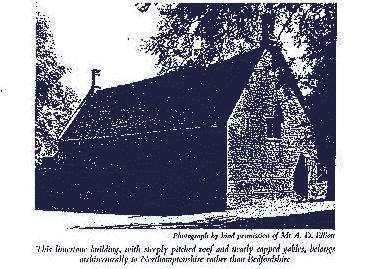 One would date most the neatly rethatched cottages seventeenth century except that their stone walls sometimes encase an earlier timber framework with moulded beams obviously of Tudor date.
One would date most the neatly rethatched cottages seventeenth century except that their stone walls sometimes encase an earlier timber framework with moulded beams obviously of Tudor date.
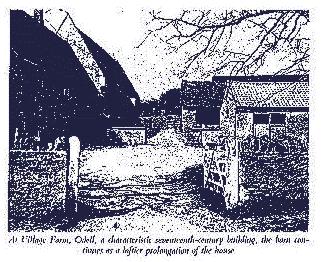 Village Farm is a characteristic seventeenth-century building, a long house with lofty attics in a steeply pitched roof with capped gables, its barn continuing as a prolongation of the house. Inside are massive chamfered beams and good fireplaces. There are, too, some excellent ranges of modern stone cottages.
Village Farm is a characteristic seventeenth-century building, a long house with lofty attics in a steeply pitched roof with capped gables, its barn continuing as a prolongation of the house. Inside are massive chamfered beams and good fireplaces. There are, too, some excellent ranges of modern stone cottages.
Odell Mill’s great undershot cast-iron wheel has long since ceased to turn, and the mill has been converted into a pleasant residence looking across the Ouse, which flows like molten glass over the little dam.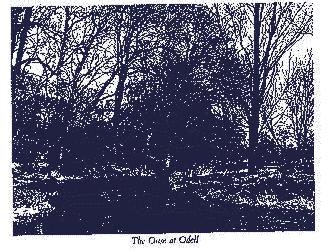
Some of Odell’s water springs were reputed to have medicinal qualities; certainly one on the north-east was well known to be mildly purgative and one, which obtained the name of Holliwell, after supplying village Farm, used to flow into a trough by the roadside for the use of villagers.
This is an area of mixed farming, with rich loam in the valley and thinner soil on the rising limestone hills. Walk up the steep High Street and you look out over acres of agricultural country, fields of all shapes interspersed with woods and copses; and ever glimpses of the silvery sheen of the Ouse, winding in gentle deliberation between osiers and willows. For all its lazy charm, the river has its rougher moods and occasionally overflows its banks with uncomfortable results, as they can tell you down at Mill Lane and at the crossroads where the Bell Inn stands.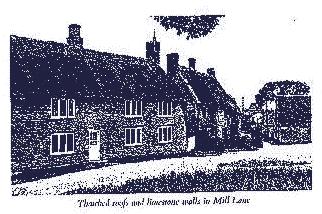
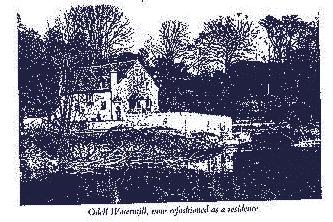
Westward is Odell Great wood, "the noblest in the county". Once it was part of the dense forest that stretched to the Fens and gave employment to many woodmen, as the large sheep-wold, enclosed in 1776, did to graziers. The ancient oaks have gone but others are maturing and it is in process of replanting with larch, sycamore and ash. No pigs root in the woods nowadays; instead game birds are reared in wired compounds, while sheep graze in the adjoining meadows. Earthy tracks run between green solitudes where primroses flourish, gleaming page gold among last year’s sered leaves.
Grey squirrels, bushy tails held upright, scuttle among the brushwood and even across your path, and a variety of bird calls go with you until you come out by the gamekeeper’s gibbet. Here stoats, weasels, jays, owls and coal-black crows have met the same end as their victims. Nailed fast, the latest arrivals are glossy and gleaming, the others, meant to be a gruesome warning to their progeny and kin, are wasting away to mere fur and feathers. But others still persist, as bold and bloodthirsty as ever, and the gamekeeper continues to wage his own private war.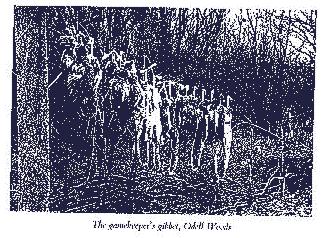
Electronic mail address
jon-hudson@ti.com
FAX number
01234-721004
Back to the Odell Home Page
Last revised: January 25th, 1998.
 Of his successors, the lords of Odell Castle, his great-great-grandson, Simon, was a wild fellow who was involved in a raid on the abbey of Ramsey and who sided with the young Prince Henry when he was revolting against his father. His son, another Simon, was as devout as his father was roisterous, and met his death by falling overboard in Acre harbour whilst on a crusade in 1191.
Of his successors, the lords of Odell Castle, his great-great-grandson, Simon, was a wild fellow who was involved in a raid on the abbey of Ramsey and who sided with the young Prince Henry when he was revolting against his father. His son, another Simon, was as devout as his father was roisterous, and met his death by falling overboard in Acre harbour whilst on a crusade in 1191. By the sixteenth century, the Odell estate had come to Agnes Woodhall (the surname had taken this form in the 1300s). She married a Hockliffe man, Richard Chetwood, and their son Richard sought vainly to have his claim as baron of Odell recognised, a claim his eighteenth and nineteenth-century descendants revived without success. In 1633, Richard sold the estate to William Alston and, after five hundred years, the Wahulls or Woodhalls disappeared from Bedfordshire history.
By the sixteenth century, the Odell estate had come to Agnes Woodhall (the surname had taken this form in the 1300s). She married a Hockliffe man, Richard Chetwood, and their son Richard sought vainly to have his claim as baron of Odell recognised, a claim his eighteenth and nineteenth-century descendants revived without success. In 1633, Richard sold the estate to William Alston and, after five hundred years, the Wahulls or Woodhalls disappeared from Bedfordshire history. And so it stood, a stone-build mansion of some magnificence, with its stable yard and broad terraced lawns which were once the outer bailey, the great well called King John’s Well, its "Monk’s hall", panelled in dark oak, its Renaissance south-facing façade, with finely moulded window frames and chimney-caps, and its rooms hung with old oil paintings. Until February 24th, 1931.
And so it stood, a stone-build mansion of some magnificence, with its stable yard and broad terraced lawns which were once the outer bailey, the great well called King John’s Well, its "Monk’s hall", panelled in dark oak, its Renaissance south-facing façade, with finely moulded window frames and chimney-caps, and its rooms hung with old oil paintings. Until February 24th, 1931. Old Mrs. Ashton, who lives in a little low-ceilinged cottage in the High Street, was a servant for many years in the big house and remembers it well: a whole sheep hanging in the cellar, the oil-lamps and candles, the dark panelling, the eighty-foot deep King John’s Well where the butler used to hang the champagne; and the ghost - a smoky black insubstantial apparition that frightened the life out of her. Others, too, claimed to have seen the spectre, but none knew to whom the unquiet spirit had belonged.
Old Mrs. Ashton, who lives in a little low-ceilinged cottage in the High Street, was a servant for many years in the big house and remembers it well: a whole sheep hanging in the cellar, the oil-lamps and candles, the dark panelling, the eighty-foot deep King John’s Well where the butler used to hang the champagne; and the ghost - a smoky black insubstantial apparition that frightened the life out of her. Others, too, claimed to have seen the spectre, but none knew to whom the unquiet spirit had belonged. A stone’s throw away is All Saints Church, a noble fifteenth-century building with a tall and massive tower, made the more commanding by its high situation. Even the churchyard, with its chestnut trees, stands well above the level of the road. To the fact that it was built all at one time, the church owes its harmony of style and proportion. Brown ironstone was used for the ornament around the corona of the tower and at each angle are large crocketed pinnacles.
A stone’s throw away is All Saints Church, a noble fifteenth-century building with a tall and massive tower, made the more commanding by its high situation. Even the churchyard, with its chestnut trees, stands well above the level of the road. To the fact that it was built all at one time, the church owes its harmony of style and proportion. Brown ironstone was used for the ornament around the corona of the tower and at each angle are large crocketed pinnacles. The priests’ seats are stepped in three levels under a traceried window. There is a Jacobean altar table and a pulpit of the same date with an iron frame close by which held the hour-glass by which former rectors timed their sermons. Lady Wolstenholme contributed a pulpit cloth and a velvet cushion on which she had embroidered her own cypher.
The priests’ seats are stepped in three levels under a traceried window. There is a Jacobean altar table and a pulpit of the same date with an iron frame close by which held the hour-glass by which former rectors timed their sermons. Lady Wolstenholme contributed a pulpit cloth and a velvet cushion on which she had embroidered her own cypher. One would date most the neatly rethatched cottages seventeenth century except that their stone walls sometimes encase an earlier timber framework with moulded beams obviously of Tudor date.
One would date most the neatly rethatched cottages seventeenth century except that their stone walls sometimes encase an earlier timber framework with moulded beams obviously of Tudor date.  Village Farm is a characteristic seventeenth-century building, a long house with lofty attics in a steeply pitched roof with capped gables, its barn continuing as a prolongation of the house. Inside are massive chamfered beams and good fireplaces. There are, too, some excellent ranges of modern stone cottages.
Village Farm is a characteristic seventeenth-century building, a long house with lofty attics in a steeply pitched roof with capped gables, its barn continuing as a prolongation of the house. Inside are massive chamfered beams and good fireplaces. There are, too, some excellent ranges of modern stone cottages.


